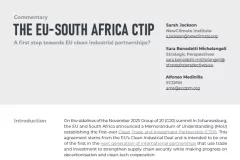In stark contrast to the overwhelming wave of optimism for climate action from school children, students, and civil society across the world throughout 2019, the 25th Conference of the Parties (COP) in Madrid closed on Sunday 15th December 2019 with an underwhelming outcome – more damage control than progress on climate ambition. Despite major delays, while Parties scrambled to reach an agreement, delegations departed on Sunday without having reached a consensus on many of the main sticking points.
Among several issues on the table, negotiators could not agree on rules for the use of international carbon markets towards the achievement of countries’ climate change pledges. This would have concluded one of the last remaining elements of the rulebook for the implementation of the Paris Agreement.
The conference in Madrid is a disappointment for many and a clear indication of the limits of the consensus-based UN negotiating process in the era of rising populism. Despite having started the process to withdraw from the Paris Agreement, the US joined with Brazil, Japan and Australia to undermine what had already been agreed in Paris.
A compromise on markets might have undermined the whole Paris Agreement
Depending on the strength of the rules, international carbon markets could either prove to be an opportunity for countries to increase their level of climate ambition according to their capacity and historical responsibility, or a loophole for countries to continue polluting. Several high-level delegates, including Svenja Schulze, Germany’s Minister for Environment, and Bas Eickhout, head of the EU delegation, indicated at the half-way point of the COP that they thought that no deal would be better than a bad deal. They are right. Under pressure to reach consensus, countries might have made compromises with serious negative consequences for the overall ambition of the Paris Agreement. It is highly regrettable that an agreement could not be struck with strong rules to ensure the integrity of the Paris Agreement, but a compromise would have been worse.
The San Jose Principles outline the basis for “High Ambition and Integrity in International Carbon Markets”, upon which a fair and robust carbon market should be built. It was published almost at the last minute by a group of countries working to ensure that an ambitious outcome is delivered on the negotiations for Article 6 of the Paris Agreement, which addresses the use of international carbon markets. Although the publication of those principles was a positive development, they remain high level and vague.
Despite the publication of those principles to guide the negotiations, a consensus on fundamental issues including the following could not be reached:
- “Corresponding adjustments”, through which countries adjust their own GHG emission accounts to account for emission reductions that have been sold or transferred abroad, are essential to avoid that any emission reductions are “double counted”. A handful of countries, rallied most notably by Brazil, argued against adequate rules for corresponding adjustments, but ambitious Parties made it repeatedly clear that this was a red line that could not be crossed.
- Several countries lobbied for the transition of pre-2020 emission reduction credits, in particular from the Clean Development Mechanism, into the new market mechanism established by Article 6.4 of the Paris Agreement. Allowing Parties to use surplus credits from historical markets towards their future targets would immediately reduce the ambition of the already insufficient existing pledges under the Paris Agreement. Ambitious countries resisted such a transition, but several seemed willing to move on that position to reach an agreement.
- The effective implementation of a "share of proceeds” for administrative purposes and to ensure continued finance for the Adaptation Fund is still a contentious issue for some Parties, although this was proven to be a successful concept under the Kyoto Protocol’s CDM, and there is a clear mandate for it in Article 6.6 of the Paris Agreement.
- The Paris Agreement also made it clear that the any new international market mechanism needs to deliver an “overall mitigation in global emissions”. Some parties were fixed on options that would not guarantee this goal. An efficient implementation approach is one which mirrors the approach for the share of proceeds. This is the simplest and most secure approach to ensure that the already agreed text of the Paris Agreement is not undermined by its own rulebook.
The negotiations in Madrid provide a reminder to countries – even ambitious ones – about the danger of compromising. Reneging on red lines on the issues above could have undermined ambition in the Paris Agreement for years to come, as well as potentially weakening the effectiveness of schemes outside the UNFCCC, which includes international aviation’s offsetting mechanism, CORSIA.
Parties should move ahead on the pressing issue of domestic ambition
The lack of an agreement on Article 6 is disappointing, not least because continued negotiations on this element of the Paris Agreement rulebook have distracted attention from the most pressing issue: domestic decarbonisation. Existing pledges and policies remain a woefully inadequate response to the agreed objectives of the Paris Agreement, and it is imperative that Parties ratchet up the ambition of their NDCs in 2020 to close this gap. At this point, Parties should consider scaling back their expectations for Article 6 for the time being, in order to focus all efforts on that most pressing issue of reducing GHG emissions domestically.
This need not hold back international cooperation. Parties should consider how other means of international non-market cooperation can scale up the flow of international climate finance, mobilising private sector investment and redoubling efforts for capacity building and technology transfer. Fundamental issues related to common NDC features, common time frames, and provisions for “clarity, transparency, and understanding” are an essential foundation for ambitious international market mechanisms – more work is still needed here. Markets need to lead to overachievement of updated ambitious NDCs in order to sell emission reductions to others. Most countries have not yet reached this point and are therefore not ready for the use of ambitious Article 6 rules, even if they were to exist.
Looking ahead for ambition in 2020
Negative messages dominated COP 25 in 2019. Global CO2 emissions again rose in 2019 after a plateau between 2013 and 2016. The US, Brazil and Australia seem to be jointly at odds to the Paris Agreement, obstructing progress and ambition.
At the same time, the opportunities to raise ambition in 2020 are better than they have ever been before. The cost of renewable energy and battery storage are falling rapidly; countries can do much more today than they could when they agreed to the objectives of the Paris Agreement. If done right, more climate action means more secure and high-quality jobs, more energy security, cleaner air and water. Cities, regions and businesses continue to showcase ambitious actions and have the potential to narrow the emissions gap. Best practices needed to keep warming under 1.5°C are already happening at the speed required, but not yet on the scale necessary.
Leadership is needed from actors at all levels to realise the opportunities on offer in 2020:
- Parties’ full focus must be on domestic ambition. Parties should take the opportunity in 2020 to enhance the ambition of their NDCs and set out long term strategies to demonstrate their commitment to what was agreed in the Paris Agreement. Expectations for carbon market negotiations should be scaled back to fully focus on this most important issue.
- Strong ambitious coalitions should feel responsibility to fill the void left by the US and other rebelling powers, to avoid another disappointing outcome at COP 26 in Glasgow. The EU needs to quickly decide on increased ambition at home and then could strike a deal with other influential Parties such as China, to move ahead. In parallel, smaller active countries and regions need to continue to pursue the transition to demonstrate that fast action is possible and even beneficial for countries’ own economies.
- The international process should seek to enhance the voice and enable the action of non-state actors, who currently demonstrate the most encouraging momentum for climate action.
- Grass roots initiatives and activism, which have exerted considerable pressure on governments in 2019, should not be disheartened but should double down to ensure ambition in 2020.
The lack of an agreement on key aspects of the Paris Agreement rulebook is a setback, but this issue should not distract from increased ambition and the implementation of policies for action at the domestic level. All efforts should be concentrated on taking the opportunity to achieve that in 2020, which must mark the year when countries set out serious plans for decarbonisation and prevent laggards from dictating their speed and ambition.






